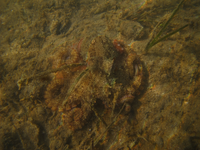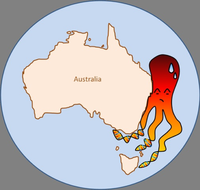Diving into the genetics of range shifts
Dr Jorge E. Ramos, 27 Jun 2018.
Jorge E. Ramos is a marine biologist with a PhD in Natural and Physical Sciences from the University of Tasmania. His PhD project focused on examining the life-history characteristics, genetics and population dynamics of the range extending common Sydney octopus (Octopus tetricus).
---
Searching for patterns in the genetics of range-shifting animals can help us to understand why some animals, and not others, are shifting where they live in response to climate change. Sightings of the common Sydney octopus (Octopus tetricus) in Tasmanian waters (logged with Redmap!) provided the motivation for studying the genetics of this range-shifting marine species. Here, Jorge describes interesting genetic patterns across the shifting distribution of Octopus tetricus.
Shifts in the distributions of marine species are occurring globally in response to ocean warming associated with climate change. As waters warm, species in the northern hemisphere are moving north, whereas species in the southern hemisphere are moving south. However, our understanding of the biological and ecological processes that are involved in these changes is still pretty limited. Studying the genetics of species that have shifted into new areas can help us understand how and why some animals are able to respond to changing conditions by shifting where they live, and why other species can’t - or haven’t just yet.
The common Sydney octopus (Octopus tetricus), also known as the gloomy octopus, has historically been found off Australia’s east coast between southern Queensland and southern New South Wales. However, this species was detected off Flinders Island, Bass Strait, by commercial fishers in 2006, and again off south-eastern Tasmania by Redmap contributors in 2010. Sightings of the common Sydney octopus in Tasmanian waters suggest that this species is potentially shifting its distribution further south, and provided the initial motivation to examine how genetic processes may affect the capacity of range-shifting species to establish and persist in new areas.
Key points
Assessing the genetics of common Sydney octopus sampled at eight locations between northern New South Wales and north-eastern Tasmania revealed that:
1. Common Sydney octopus from the historical distribution (i.e. along NSW) were genetically different from individuals in the new region (that would be Tassie!) where this species has moved into. This finding suggests that populations of common Sydney octopus have been separated for some time and their genetic makeups are likely to have been shaped by different environmental conditions, such as warm vs.temperate waters.
2. The genetics of the common Sydney octopus sampled from its new home in Tassie are currently being sustained by individuals from both Tassie itself and the mainland population. Hitching a ride with the south flowing East Australian Current is something larvae and juveniles of many marine species do. This means that the Tassie gloomy octopus populations get genes delivered from along the east coast of Australia.
3. The Tasmanian gloomy octopus appears to be maintaining genetic diversity thanks to the genes that are received from along the east coast of Australia. This is really interesting because range-shifting populations often suffer a decrease of genetic diversity that will often negatively affect the population. These genetic patterns appear to be assisting the common Sydney octopus to establish and persist in the new areas of its distribution.
This study has been recently published in the peer-reviewed journal Scientific Reports, and can be viewed here: https://rdcu.be/1qyr













